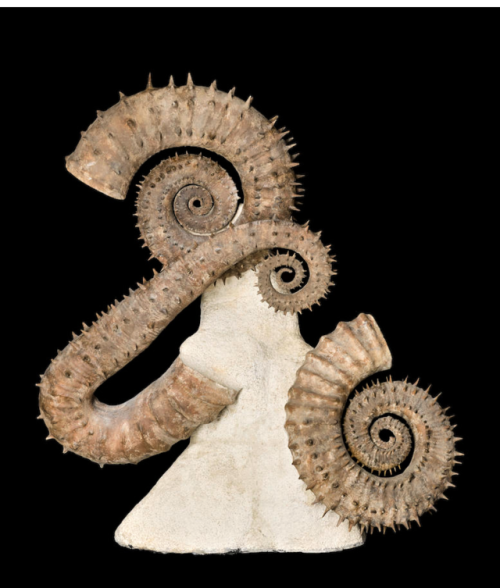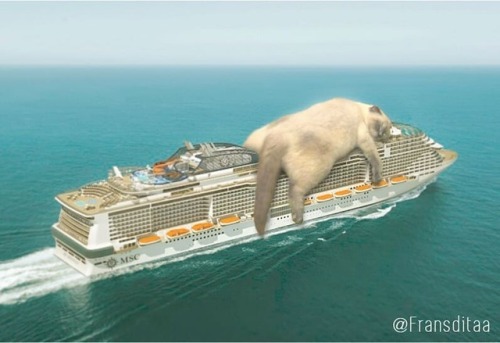Heteromorph Ammonites With Spikes (Emericiceras Alpinum, Ancyloceras Vandenbecki, Emericiceras Barremense)

Heteromorph Ammonites with spikes (Emericiceras alpinum, Ancyloceras vandenbecki, Emericiceras barremense) Cretaceous, Lower Barremian - Agadir, Morocco
More Posts from Iphleandro-blog and Others








Pokemon Spectrum | by gogoatt





Via Peyton Thomas










Catzillas: Giant Cats In Urban Landscapes
Indonesian artist Fransdita Muafidin publishes a series of photomontages with kittens and fat adult cats among the urban landscapes from around the world.
Via Design You Trust

Like milk, coffee is a nutritional output. It comes from the rare FistPumpius Caffeinius.




The concept of information as viewed in theoretical physics through statistical mechanics and thermodynamics, and its implications and connections with evolutionary biology. An interesting reading:
How Life (and Death) Spring From Disorder (via WIRED -original story from Quanta Magazine)
Biological systems don’t defy physical laws, of course—but neither do they seem to be predicted by them. In contrast, they are goal-directed: survive and reproduce. We can say that they have a purpose—or what philosophers have traditionally called a teleology—that guides their behavior.
By the same token, physics now lets us predict, starting from the state of the universe a billionth of a second after the Big Bang, what it looks like today. But no one imagines that the appearance of the first primitive cells on Earth led predictably to the human race. Laws do not, it seems, dictate the course of evolution.
–
David Kaplan explains how the law of increasing entropy could drive random bits of matter into the stable, orderly structures of life.
JÓVENES INVESTIGADORES: 1.PALEONTOLOGÍA
Young researchers in paleontology. Universidad Autónoma de Madrid




These are just amazing!
Moth is not a four-letter word for this UK knitter! | KnitHacker
Max Alexander‘s knitted moths are incredible – I am simply blown away. LOVE! I also like the irony of using wool to knit moths – normally that combination strikes fear into the heart of every knitter/crocheter I know!
African Cherry Spot Moth
Knitted Merveille du Jour Moth
Tatargina Picta Moth
Peach Blossom Moth
fms.fossils
Here was a lucky little find from today’s fossil hunt on Charmouth beach. This is a pyrite ammonite of the species Echioceras raricostatum. They are preserved in very soft shale, as you can see, which means that they come out in one piece very easily. Usually, the sea pulls them out of the rocks and dumps them on the beach. This can easily damage or destroy them. This one has a thin calcite shell on top of the pyrite which would have been removed by the sea almost instantly if it had got to it before I did. This fossil is around 196 million years old.

Map of US National Parks

-
 natvre reblogged this · 1 month ago
natvre reblogged this · 1 month ago -
 ariesascending reblogged this · 2 months ago
ariesascending reblogged this · 2 months ago -
 dragononymous liked this · 2 months ago
dragononymous liked this · 2 months ago -
 zerr-issen reblogged this · 3 months ago
zerr-issen reblogged this · 3 months ago -
 nightmar-y reblogged this · 3 months ago
nightmar-y reblogged this · 3 months ago -
 goblinofthewoods reblogged this · 3 months ago
goblinofthewoods reblogged this · 3 months ago -
 elysian-lullaby liked this · 3 months ago
elysian-lullaby liked this · 3 months ago -
 ladyfilianore liked this · 4 months ago
ladyfilianore liked this · 4 months ago -
 rahorarty liked this · 4 months ago
rahorarty liked this · 4 months ago -
 oftwodarkmoons reblogged this · 6 months ago
oftwodarkmoons reblogged this · 6 months ago -
 humancorps3 liked this · 6 months ago
humancorps3 liked this · 6 months ago -
 aardwolfpack reblogged this · 7 months ago
aardwolfpack reblogged this · 7 months ago -
 centre-cannot-hold reblogged this · 7 months ago
centre-cannot-hold reblogged this · 7 months ago -
 centre-cannot-hold liked this · 7 months ago
centre-cannot-hold liked this · 7 months ago -
 derkow-derkow liked this · 8 months ago
derkow-derkow liked this · 8 months ago -
 procyonis liked this · 9 months ago
procyonis liked this · 9 months ago -
 bigfettuccine liked this · 9 months ago
bigfettuccine liked this · 9 months ago -
 carabid reblogged this · 9 months ago
carabid reblogged this · 9 months ago -
 laminatednewspaper liked this · 9 months ago
laminatednewspaper liked this · 9 months ago -
 eleventeenthealbum reblogged this · 9 months ago
eleventeenthealbum reblogged this · 9 months ago -
 gracelandmp3 reblogged this · 9 months ago
gracelandmp3 reblogged this · 9 months ago -
 basketcat reblogged this · 9 months ago
basketcat reblogged this · 9 months ago -
 saintflint reblogged this · 9 months ago
saintflint reblogged this · 9 months ago -
 lutefisk-kingdom liked this · 9 months ago
lutefisk-kingdom liked this · 9 months ago -
 noaheinarwingren liked this · 9 months ago
noaheinarwingren liked this · 9 months ago -
 erebus-luckycharm reblogged this · 9 months ago
erebus-luckycharm reblogged this · 9 months ago -
 blinnd reblogged this · 9 months ago
blinnd reblogged this · 9 months ago -
 lemoncoughdrop liked this · 9 months ago
lemoncoughdrop liked this · 9 months ago -
 selfundiagnosed reblogged this · 9 months ago
selfundiagnosed reblogged this · 9 months ago -
 hypnophobe liked this · 9 months ago
hypnophobe liked this · 9 months ago -
 sleepy-jabberwocky liked this · 9 months ago
sleepy-jabberwocky liked this · 9 months ago -
 morgvl reblogged this · 9 months ago
morgvl reblogged this · 9 months ago -
 morgvl liked this · 9 months ago
morgvl liked this · 9 months ago -
 iignatz reblogged this · 9 months ago
iignatz reblogged this · 9 months ago -
 aatmadevata liked this · 9 months ago
aatmadevata liked this · 9 months ago -
 lunetlesoleil reblogged this · 9 months ago
lunetlesoleil reblogged this · 9 months ago -
 lunetlesoleil liked this · 9 months ago
lunetlesoleil liked this · 9 months ago -
 aguja-magnetica liked this · 9 months ago
aguja-magnetica liked this · 9 months ago -
 cahalamaeuballe reblogged this · 9 months ago
cahalamaeuballe reblogged this · 9 months ago -
 cahalamaeuballe liked this · 9 months ago
cahalamaeuballe liked this · 9 months ago -
 tiger-feather reblogged this · 9 months ago
tiger-feather reblogged this · 9 months ago -
 flowers-will-bloom reblogged this · 9 months ago
flowers-will-bloom reblogged this · 9 months ago -
 mademoisellemort reblogged this · 9 months ago
mademoisellemort reblogged this · 9 months ago -
 anasphalia liked this · 9 months ago
anasphalia liked this · 9 months ago -
 iignatz liked this · 9 months ago
iignatz liked this · 9 months ago